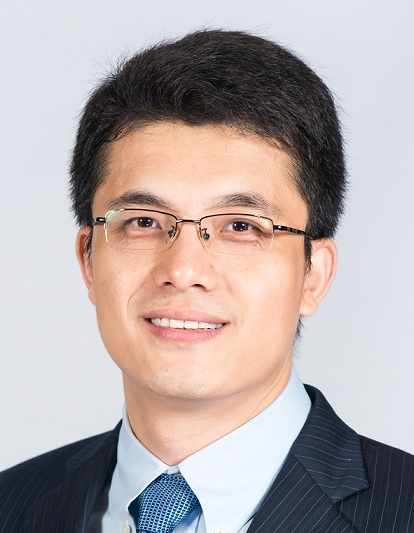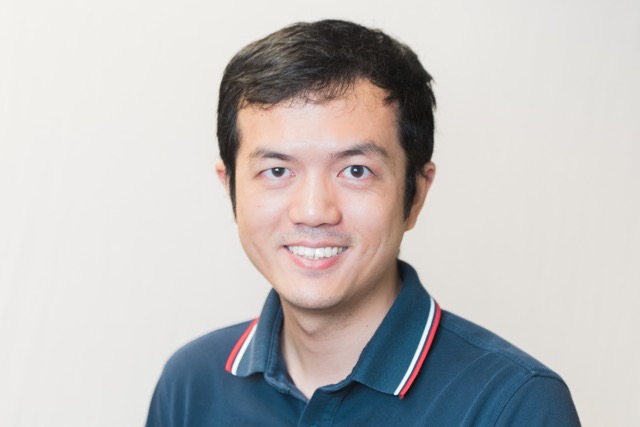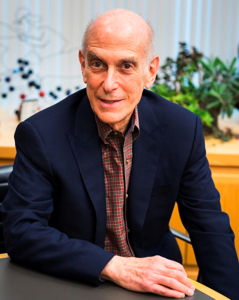

Monday, December 11, 2017, 3:30pm - 4:30pm, WEL 2.122 
Assistant Professor of Chemistry
University of Michigan
Research in our laboratory focuses on innovations in modern synthetic organic and organometallic chemistry to address fundamentally interesting questions of biological importance. Our primary aim is to develop new synthetic methodologies to enable the synthesis and evaluation of biologically active target structures, often derived and inspired by natural products.
Monday, December 4, 2017, 3:30pm - 4:30pm, WEL 2.122 
Associate Professor of Chemistry
National University of Singapore
Research interests of our lab lie in the discovery and development of efficient, selective as well as economical catalytic methods for chemical synthesis, with an emphasis on asymmetric catalysis. Research efforts will be focused on the identification of new activation modes for the conversion of feedstock molecules to useful organic compounds, the introduction of new approaches for catalyst discovery, and understanding the reaction mechanism. Application of the new methods toward the synthesis of molecules with a complex structure and/or useful functions will serve as a testament of the efficacy of the method development. Ultimately, the goal is to provide new chemical tools to bear on contemporary problems in the applied areas such as pharmaceuticals, chemical biology and material science.
[Due to author name ambiguity, author metrics can't be determined.]
Faculty Recruiting Seminar
Monday, November 27, 2017, 3:30pm - 5:00pm, WEL 2.122
Research Associate
Scripps Research Institute
Dr. Mortenson is a postodoctoral researcher in the laboratories of Ian A. Wilson and Jeffery W. Kelly.
Wilson Group: Crystallographic Studies of Immune Recognition and Viral Pathogens. Our main focused is on immune recognition and on how pathogens are recognized by the adaptive and innate immune systems. Our major goals are to understand the interaction and neutralization of foreign antigens by the immune system through structural studies using mainly high-resolution X-ray crystallography. The information derived from these studies is being used to develop antigens and immunization regiments to elicit broadly neutralizing antibodies against viral pathogens, such as influenza virus and HIV-1.
Kelly Group: A central theme of our research is to understand the chemistry and biology of protein homeostasis (proteostasis) and the influence of proteostasis pathways on the competition between protein folding, misfolding and aggregation, the latter two processes being associated with a spectrum of human diseases. A recent focus has been on adapting the innate biology of protein maintenance carried out by the proteostasis network within the cell pharmacologically to enhance the folding and trafficking or clearance of aggregation-prone and/or misfolding-prone proteins.
Publications (Web of Science)
1. Chen, W. T.; Dong, J. J.; Plate, L.; Mortenson, D. E.; Brighty, G. J.; Li, S. H.; Liu, Y.; Galmozzi, A.; Lee, P. S.; Hulce, J. J.; Cravatt, B. F.; Saez, E.; Powers, E. T.; Wilson, I. A.; Sharpless, K. B.; Kelly, J. W., Arylfluorosulfates Inactivate Intracellular Lipid Binding Protein(s) through Chemoselective SuFEx Reaction with a Binding Site Tyr Residue. Journal of the American Chemical Society 2016, 138 (23), 7353-7364.
2. Connelly, S.; Mortenson, D. E.; Choi, S.; Wilson, I. A.; Powers, E. T.; Kelly, J. W.; Johnson, S. M., Semi-quantitative models for identifying potent and selective transthyretin amyloidogenesis inhibitors. Bioorganic & Medicinal Chemistry Letters 2017, 27 (15), 3441-3449.
3. Hayouka, Z.; Mortenson, D. E.; Kreitler, D. F.; Weisblum, B.; Forest, K. T.; Gellman, S. H., Evidence for Phenylalanine Zipper-Mediated Dimerization in the X-ray Crystal Structure of a Magainin 2 Analogue. Journal of the American Chemical Society 2013, 135 (42), 15738-15741.
4. Hayouka, Z.; Thomas, N. C.; Mortenson, D. E.; Satyshur, K. A.; Weisblum, B.; Forest, K. T.; Gellman, S. H., Quasiracemate Crystal Structures of Magainin 2 Derivatives Support the Functional Significance of the Phenylalanine Zipper Motif. Journal of the American Chemical Society 2015, 137 (37), 11884-11887.
5. Hsu, C. H.; Park, S.; Mortenson, D. E.; Foley, B. L.; Wang, X. C.; Woods, R. J.; Case, D. A.; Powers, E. T.; Wong, C. H.; Dyson, H. J.; Kelly, J. W., The Dependence of Carbohydrate-Aromatic Interaction Strengths on the Structure of the Carbohydrate. Journal of the American Chemical Society 2016, 138 (24), 7636-7648.
6. Johnson, L. M.; Mortenson, D. E.; Yun, H. G.; Horne, W. S.; Ketas, T. J.; Lu, M.; Moore, J. P.; Gellman, S. H., Enhancement of alpha-Helix Mimicry by an alpha/beta-Peptide Foldamer via Incorporation of a Dense Ionic Side-Chain Array. Journal of the American Chemical Society 2012, 134 (17), 7317-7320.
7. Kreitler, D. F.; Mortenson, D. E.; Forest, K. T.; Gellman, S. H., Effects of Single alpha-to-beta Residue Replacements on Structure and Stability in a Small Protein: Insights from Quasiracemic Crystallization. Journal of the American Chemical Society 2016, 138 (20), 6498-6505.
8. Mortenson, D. E.; Kreitler, D. F.; Yun, H. G.; Gellman, S. H.; Forest, K. T., Evidence for small-molecule-mediated loop stabilization in the structure of the isolated Pin1 WW domain. Acta Crystallographica Section D-Biological Crystallography 2013, 69, 2506-2512.
9. Mortenson, D. E.; Satyshur, K. A.; Guzei, I. A.; Forest, K. T.; Gellman, S. H., Quasiracemic Crystallization as a Tool To Assess the Accommodation of Noncanonical Residues in Nativelike Protein Conformations. Journal of the American Chemical Society 2012, 134 (5), 2473-2476.
10. Mortenson, D. E.; Steinkruger, J. D.; Kreitler, D. F.; Perroni, D. V.; Sorenson, G. P.; Huang, L.; Mittal, R.; Yun, H. G.; Travis, B. R.; Mahanthappa, M. K.; Forest, K. T.; Gellman, S. H., High-resolution structures of a heterochiral coiled coil. Proceedings of the National Academy of Sciences of the United States of America 2015, 112 (43), 13144-13149.
11. Shin, Y. H.; Mortenson, D. E.; Satyshur, K. A.; Forest, K. T.; Gellman, S. H., Differential Impact of beta and gamma Residue Preorganization on alpha/beta/gamma-Peptide Helix Stability in Water. Journal of the American Chemical Society 2013, 135 (22), 8149-8152.
Friday, November 17, 2017, 2:30pm - 5:00pm, NHB 1.720
Dept. of Chemistry and Biochemistry
University of South Carolina
Organic chemists use C-C bond forming strategies to elaborate molecules generating a myriad of compounds. Nature uses amides and phosphoamides to organize huge arrays of nanomaterials. We are interested in developing predictable supramolecular chemistry using non-covalent urea-urea interactions to build an array of structures and materials with a diverse array of applications.
The general focus of our research is the templated synthesis of small molecules, molecular devices, and polymers. Areas of interest include: molecular recognition, molecular devices, molecularly imprinted polymers, sensing, supramolecular chemistry, non-covalent interactions, and physical organic chemistry.
ORCID orcid.org/0000-0001-5599-4960
ORCID orcid.org/0000-0002-0229-6541
Monday, November 13, 2017, 3:30pm - 4:30pm, WEL 2.122 
Assistant Professor of Chemistry
Texas A&M University
ORCID: orcid.org/0000-0003-4757-5664
Located at Texas A&M since 2013, our group focuses on the bottom-up synthesis and processing of ladder polymers and microporous polymer networks for applications associated with electronics and energy conversion/storage, with possible applications in a host of industries and across multiple disciplines.
 Web of Science Highly Cited Papers
Web of Science Highly Cited Papers
Zhou, Y. et al. High performance all-polymer solar cell via polymer side chain engineering. Advanced Materials 26(22), 2014, 3767-3772. DOI: 10.1002/adma.201306242
Mei, JG et al. Integrated materials design of organic semiconductors for field-effect transistors. J. Am. Chem. Soc. 135(18) 2013, 6724-6746. DOI: 10.1021/ja400881n
Fang, L. et al. Mechanically bonded macromolecules. Chem. Soc. Rev. 39 2010, 17-29. DOI: 10.1039/b917901a
Novartis Lecture
Friday, November 10, 2017, 3:30pm - 4:30pm, WEL 2.122
Professor, Dept. of Chemistry
Philipps-Universität Marburg
Main interest of our group revolves around exploiting structural aspects of octahedral transition metal complexes, often in combination with other features, for applications in organic synthesis (e.g. asymmetric catalysis) and the life sciences (e.g. design of enzyme inhibitors). Particularly, we are intrigued by the stereochemical complexity of the octahedral coordination geometry (up to 30 stereoisomers possible!) which provides untapped opportunities for the design of novel catalysts and compounds with unprecedented biological properties.
Currently, we are focusing on bis-cyclometalated iridium(III) and rhodium(III) complexes for "metal-templated organocatalysis", chiral Lewis acid catalysis and asymmetric photoredox catalysis. Note, in these catalyst, the central metal is the exclusive source of chirality.
(Web of Science, October 2017)
Friday, November 3, 2017, 3:30pm - 5:00pm, WEL 2.122
Principal Research Scientist, Lilly UK
ORCID: orcid.org/0000-0002-4450-3828
Friday, October 20, 2017, 3:30pm - 4:30pm, WEL 2.122 
Professor Emeritus
MIT, Dept. of Chemistry
Research in Professor Lippard's laboratory involves bioinorganic chemistry. The core activities include both structural and mechanistic studies of macromolecules as well as synthetic inorganic chemistry. The focus is on the synthesis, reactions, physical and structural properties of metal complexes as models for the active sites of metalloproteins and as anti-cancer drugs. Also included is extensive structural and mechanistic work on the natural systems themselves. A program in metalloneurochemistry is also in place.
(Web of Science, October 2017)
Wednesday, September 27, 2017, 3:30pm - 4:30pm, WEL 2.122
Associate Professor
University of Rochester Dept. of Chemistry
The research of the Fasan Group focuses on the design, development, and investigation of novel chemo-biosynthetic and chemo-enzymatic strategies for the discovery of biologically active molecules. Through these methodologies, we develop novel chemical agents useful for probing cell signaling pathways and controlling biomolecular interactions implicated in cancer, malaria, and other diseases. All our projects involve the synergistic integration of rational design, chemical synthesis, protein chemistry, molecular biology, and molecular evolution methods toward the development of enabling molecular discovery platforms of practical and broad utility.
(Web of Science, August 2017)
Distinguished Alumni Lecture
Monday, September 25, 2017, 3:30pm - 4:30pm, WEL 2.122
Professor (PhD, UT Austin, 2005)
Shanghai University, Dept. of Chemistry
Our group has been centered on the development reductive coupling of two different electrophiles which leads to efficient C-C bond formation. The second research field in our group emphasizes the design of strong H-bonding motif in aqueous media, which can be applied to materials and biological studies.
(Web of Science, August 2017)
Friday, July 28, 2017, 03:30pm - 04:00pm, WEL 2.122
Professor
University of Florida, Dept. of Chemistry
Research Group Web Page: sumerlin.chem.ufl.edu
ORCID 0000-0001-5749-5444
The Sumerlin Research Group investigates well-defined polymeric materials with selected functionality, composition, and molecular architecture. Our particular focus is on polymers that are water-soluble and stimuli-responsive. Such "smart" polymers have the ability to self-assemble or dissociate in solution in response to changes in their surroundings. Potential target applications include controlled and targeted drug delivery, surface modification, and the synthesis of self-healing materials. Our interests are at the interface of bio-, organic, and polymer chemistry, with particular focus on fusing the fields to prepare materials with synergistic properties.
Eva Blasco, Michael Sims, Anja S. Goldmann, Brent Sumerlin, Christopher Barner-Kowollik “Polymer Functionalization” In revision.
Bryan S. Tucker, McKenzie L. Coughlin, C. Adrian Figg, and Brent S. Sumerlin “Grafting-From Proteins Using Metal-Free PET-RAFT Polymerizations Under Mild Visible-Light Irradiation” ACS Macro Letters 2017, 6, 452-457. DOI
William L. A. Brooks, Gertjan Vancoillie, Christopher P. Kabb, Richard Hoogenboom, Brent S. Sumerlin “Triply-Responsive Block Copolymers Combining pH-Responsive, Thermoresponsive, and Glucose-Responsive Behaviors” Journal of Polymer Science, Part A: Polymer Chemistry 2017 DOI: 10.1002/pola.28615
C. Adrian Figg, Ashton N. Bartley, Tomohiro Kubo, Bryan S. Tucker, Ronald K. Castellano and Brent S. Sumerlin “Mild and efficient synthesis of ω,ω- heterodifunctionalized polymers and polymer bioconjugates” Polymer Chemistry 2017, 8, 2457-2461. Link
Xiao Wang, C. Adrian Figg, Xiaoqing Lv, Yongqi Yang, Brent S. Sumerlin, Zesheng An “Star Architecture Promoting Morphological Transitions during Polymerization-Induced Self-Assembly” ACS Macro Letters 2017, 6, 337-342. DOI
Christopher S. O’Bryan, Tapomoy Bhattacharjee, Samuel Hart, Christopher P. Kabb, Kyle D. Schulze, Indrasena Chilakala, Brent S. Sumerlin, W. Gregory Sawyer, Thomas E. Angelini “Self-Assembled Micro-Organogels for 3D Printing Silicone Structures” Sci. Adv., 2017 Link
Hao Sun, Christopher P. Kabb, Yuqiong Dai, Megan R. Hill, Ion Ghiviriga, Abhijeet P. Bapat and Brent S. Sumerlin “Macromolecular metamorphosis via stimulus- induced transformations of polymer architecture” Nature Chemistry 2017, accepted. DOI:10.1038/nchem.2730.
Jawaher A. Alfurhood, Hao Sun, Christopher P. Kabb, Bryan S. Tucker, James H. Matthews, Hendrik Luesch and Brent S. Sumerlin “Poly(N-(2- hydroxypropyl)methacrylamide)–valproic acid conjugates as block copolymer nanocarriers” Polymer Chemistry 2017, DOI 10.1039/C7PY00196G.
R. Nicholas Carmean, C. Adrian Figg, Georg M. Scheutz, Tomohiro Kubo, and Brent S. Sumerlin “Catalyst-Free Photoinduced End-Group Removal of Thiocarbonylthio Functionality” ACS Macro Letters 2017, 6, 185-189. DOI: 10.1021/acsmacrolett.7b00038
C. Adrian Figg, R. Nicholas Carmean, Kyle C. Bentz, Soma Mukherjee, Daniel A. Savin, and Brent S. Sumerlin "Tuning Hydrophobicity To Program Block Copolymer Assemblies from the Inside Out" Macromolecules 2017, 50, 935-943. DOI: 10.1021/acs.macromol.6b02754
 Recent Highly Cited Papers (Web of Science)*
Recent Highly Cited Papers (Web of Science)** Highly Cited Papers received enough citations to place them in the top 1% of their academic fields based on a highly cited threshold for the field and publication year.
The Seminars page is brought to you by the University Libraries. Our intent is to provide a quick profile of our guest speakers, links to their research group sites, recent publications, author metrics, and other information to enhance your engagement with the guests.

This work is licensed under a Creative Commons Attribution-NonCommercial 4.0 Generic License.